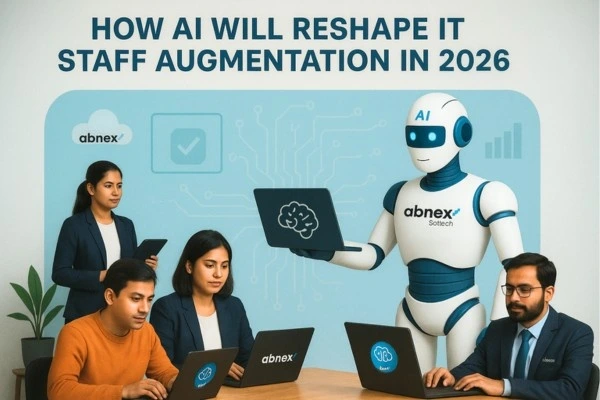How AI Will Reshape IT Staff Augmentation in 2026
Introduction: Why AI in IT Staff Augmentation 2026 Matters Now
The global tech talent race isn’t slowing down—it’s accelerating. By 2026, businesses will no longer ask if they need AI in IT Staff Augmentation 2026, but how fast they can scale it with precision. Rising project complexity, hybrid work models, and relentless digital transformation are reshaping the way companies secure skills. Traditional hiring is too slow, too costly, and too rigid.
That’s where IT Staff Augmentation steps in: a flexible, AI-enabled bridge between urgent skill demand and limited in-house supply.
The Future of IT Staff Augmentation in 2026
The staffing industry has always been about filling gaps. In 2026, those gaps aren’t just in headcount—they’re in specialized skills like AI/ML engineering, MLOps, cybersecurity, quantum computing, and blockchain development. According to industry reports, 71% of leaders now prioritize niche experts over generalists, a shift that makes IT Staff Augmentation more critical than ever.
The future will see AI staffing platforms screening resumes, predictive algorithms suggesting talent pipelines, and virtual onboarding shrinking hiring timelines by up to 40–60%. Businesses that hesitate risk missing deadlines and market opportunities.
AI-Powered IT Staff Augmentation 2026
AI is no longer a buzzword in staffing—it’s an operational backbone. In AI-powered IT Staff Augmentation 2026, artificial intelligence will:
- Automate candidate sourcing with global reach
- Screen profiles using NLP to cut recruiter workload
- Run predictive analytics to forecast staffing needs before they become urgent
- Deploy chatbots for candidate engagement, interview prep, and onboarding
Already, 58% of firms report using AI hiring tools, from resume screening to video-interview assessments. By 2026, this will be standard practice in IT Staff Augmentation.
Remote, Hybrid, and Global Talent Pools
One of the strongest trends in AI in IT workforce augmentation 2026 is the borderless workforce. Hybrid and remote setups are no longer “post-pandemic perks” but embedded operating models.
Staff augmentation partners are tapping into global hubs—from Eastern Europe’s cybersecurity specialists to India’s cloud-native engineers. AI staffing platforms make this scale possible by mapping real-time skill availability across geographies, eliminating bottlenecks of location and timezone.
For businesses, this means 24/7 development cycles, faster delivery, and reduced costs without compromising expertise. Hybrid staff augmentation with AI will become the default.
Benefits of AI in IT Staff Augmentation
The advantages are practical, not theoretical:
- all points in this tag
- Faster Time-to-Market: Cutting hiring timelines by 30–50%
- Cost Efficiency: Saving 40–60% compared to traditional recruitment models
- Flexibility: Scaling teams up or down based on project demands
- Access to Niche Experts: AI/ML, cybersecurity, quantum skills that are otherwise impossible to hire in-house
- Reduced Risk: Avoiding long-term payroll commitments in uncertain markets
For CIOs and CTOs under pressure to deliver faster and leaner, the benefits of AI in IT Staff Augmentation make it non-negotiable.
IT Staff Augmentation vs Outsourcing: Where AI Makes the Difference
The outsourcing vs. staff augmentation debate is not new, but in 2026 the lines blur. Outsourcing often hands over entire projects to third-party vendors, while IT Staff Augmentation gives companies direct control of extended teams.
The AI factor tilts the balance: augmentation providers now use AI-driven staffing models 2026 to integrate external talent seamlessly with internal teams. This creates the best of both worlds—control plus flexibility.
IT Staff Augmentation Process in 2026
The process has evolved:
- Requirement Gathering: Businesses feed project needs into AI staffing platforms
- Talent Mapping: Algorithms match niche skills from global pools
- Screening: AI-assisted assessments ensure technical and cultural fit
- Onboarding: Digital workflows, automated documentation, compliance checks
- Integration: Staff blend into internal teams through hybrid collaboration tools
This streamlined process means IT Staff Augmentation hiring that once took months now happens in weeks—or even days.
IT Staff Augmentation Contracts and AI-Driven Staffing Models
Contracts are shifting from time-and-material (T&M) models to outcome-based agreements. In AI-driven staffing models 2026, businesses aren’t just paying for hours logged; they’re investing in deliverables.
AI enhances this by tracking productivity metrics, project milestones, and quality KPIs in real time. Transparency rises, disputes fall.
Industry Hotspots Driving IT Staff Augmentation
Different industries are fueling growth:
- BFSI: Heavy investments in analytics, automation, and AI-driven compliance
- Healthcare: Demand for telemedicine, medical data analytics, and cybersecurity
- E-commerce & Retail: Personalization engines, AI-driven supply chain automation
- Manufacturing: IoT, digital twins, predictive maintenance specialists
Each vertical is leaning on IT Staff Augmentation with AI to fill knowledge gaps at speed.
How AI in IT Staff Augmentation 2026 Impacts ROI and Cost Savings
Every CIO and CFO ultimately asks the same question: “What’s the return on investment?” With AI in IT Staff Augmentation 2026, the ROI story is straightforward and measurable.
- Reduced Hiring Costs: Traditional recruitment agencies can cost 20–25% of annual salaries in fees. With AI-powered staff augmentation, automated sourcing and screening slash these expenses by up to 50%.
- Shorter Time-to-Productivity: AI-assisted onboarding cuts ramp-up time significantly, enabling augmented staff to start contributing to projects in days, not weeks. Faster onboarding equals earlier revenue capture.
- Optimized Workforce Utilization: AI-driven staffing models match not just skills but project timelines, ensuring you never over-hire or keep idle resources. That directly reduces wasted spend.
- Lower Attrition Costs: By analyzing behavioral and performance patterns, AI predicts turnover risks early, allowing corrective action before businesses lose money on rehiring and retraining.
- Outcome-Based Pricing Models: Instead of paying for hours logged, companies invest in deliverables—meaning every dollar spent is tied to tangible results.
Businesses that adopt AI-powered IT Staff Augmentation report 30–45% higher ROI compared to traditional staffing models. For enterprises running multimillion-dollar digital transformation programs, that difference translates into millions saved and faster project payback.
Challenges in IT Staff Augmentation 2026
It’s not all smooth. Key challenges include:
- Knowledge Transfer Failures: Still a problem in 58% of augmentations
- Data Security Risks: Especially with remote talent spread across geographies
- Onboarding Gaps: Inconsistent documentation and compliance tracking
- Cultural Fit Issues: AI can’t fully solve human integration challenges—yet
Leaders must factor these risks into contracts and IT Staff Augmentation frameworks.
The Future Outlook: What’s Next for AI in IT Staff Augmentation 2026 and Beyond
By 2026, AI in IT Staff Augmentation will evolve into a strategic growth lever, not just a stop-gap. Expect:
- Predictive AI-driven staffing as a standard
- Greater adoption of hybrid and outcome-based contracts
- Specialized augmentation in AI/ML, blockchain, and cybersecurity
- Tight integration with digital transformation roadmaps
The winners will be those who use AI-powered IT Staff Augmentation not just to “fill seats” but to accelerate innovation pipelines.
Conclusion: How Abnex Softech Helps You Lead in IT Staff Augmentation 2026
AI in IT Staff Augmentation 2026 isn’t just about plugging holes—it’s about future-proofing businesses in a volatile market. With AI at the center, companies can source smarter, scale faster, and control costs without sacrificing quality.
At Abnex Softech, we don’t just follow the trends; we set them. From AI-powered candidate screening to global hybrid talent pools, we build augmentation models that drive results—not just headcounts.
Ready to future-proof your IT projects? Explore our insights on the Abnex Softech Blog or connect with us directly to discuss how we can shape your staffing strategy for 2026 and beyond.









